The Bagpipe Society
Piping Down, The changing status of the bagpiper from 12th to the 17th centuries
The changing status of the bagpiper from the 12th to the 17th centuries
Bagpipes have, of course, proliferated throughout many parts of the globe and over many centuries. The continuing and revived traditions are perhaps stronger than at any time in history and looking back at the long and varied story of this wonderful instrument, a complex interwoven quilt presents itself, with myriad manifestations from the subtly similar to the outrageously varied. When we look though at the actual status of the bagpipes and pipers themselves the story is not quite as rose-tinted. In this article I will consider the gradual displacement in status both professionally and socially and what were the causes for this.
I begin in the twelfth century, being the period when the first pictorial and carved images of pipers were being produced in abundance. Usually, when researching information on individual musicians or instruments, the first port of call is court and civic accounting records - they are literally cold and calculated and bear none of the caveats that one has to accord to other sources of evidence. However, the further back one goes in time these records become more and more unreliable and infrequent and in the case of the bagpipes there is a real paucity of any such reliable sources. The next tack is then to turn to other areas: visual representations and literary and poetic references. In terms of portrayals, these are numerous and varied, and span the whole time period of this survey. There are dozens of variant sizes and designs of bagpipes, some with single or double chanters, some with multiple drones, or with unseen or apparently non-existent drones. Chanters are conical and cylindrical, the players celestial, comical, literal or bestial.1 These depictions are to be found in the pages of decorated manuscripts from the medieval period and then in printed woodcuts and engravings in early modern prints.

From the twelfth to the sixteenth centuries bagpipers are depicted in a variety of different settings. Largely they are set in pastoral or other outdoor contexts, but they do appear frequently in indoor spaces, most often in representations of feasts. It is from the evidence of these images, where the pipers are to be seen in the presence of nobility and in an official capacity as court musician, that we can definitely state that the bagpipes were an accepted element of the courtly sound world in this early period, heralding in courses of a banquet and playing for the dances that followed.2
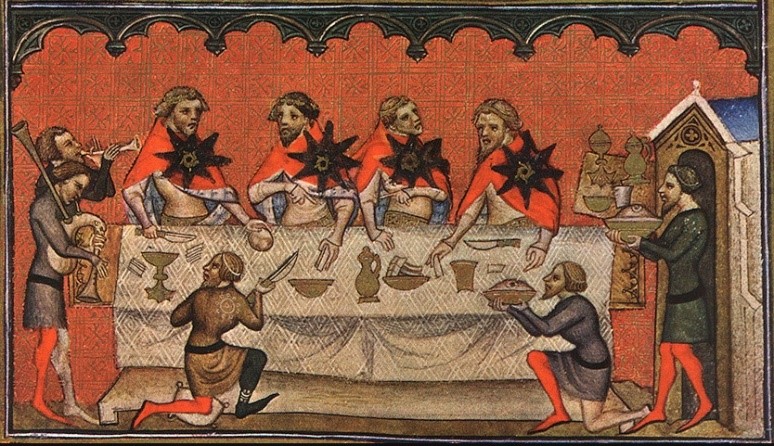
Some of the earliest examples of bagpipers in a courtly setting are to be found in the thirteenth century manuscript, the ‘Cantigas de Santa Maria’ from the court of Alfonso X ’el Sabio’ of Castile and Léon [1252-1284]. One of the copies of this marvellous collection of narrative miracle songs and prayers contains, over every tenth cantiga, an illumination of a pair of instrumentalists. Three of these images show bagpipers playing different types of pipes, one soloist with a multi-drone, double chanter instrument and two with pairs of instruments, one with what appears to be a drone free instrument and with a curved [horn?] extension. The other describes a pair of ornate pipes with chanter and drone pillar side by side but separate enough for the hand to pass between them.
Otherwise, there are plenty of examples of what would constitute a pastoral setting for noble, courtly dances. Groups of well-dressed men and women dance together outside, usually in communal dances, such as the carole or farandole, both line or circle dances that require several participants and having an unfixed length. Bagpipes on their own or with another instrument are commonly illustrated. The bagpipe’s association with dancing, at any level of society is a constant in visual evidence throughout the period.
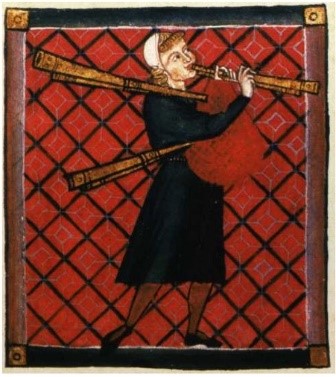
Bagpipers who were lucky enough to acquire a ‘professional’ position as a court or civic musician were generally part of a larger group of wind players. These others were players of shawms and trumpets, pipe and taborers and players of ‘soft’ instrument such as harp, vielle, lute and gittern, flutes and recorders. These players of the loud and soft instruments would have been very much separate units, occupying different spaces and functions.3 The loud instruments would have played for large gatherings which required fanfares, entry music and dances, whilst the softer instruments were played in far more intimate surroundings, private chambers, courtyard gardens and for pairs of dancers rather than large groups. Whilst of course there was a practical element to all this - it made sense for the loud instruments to play in busy and large spaces in order to be heard, and in a small confined space they would have been far too loud, there was also though a hierarchical aspect to this: loud wind and brass players were regarded negatively as those who practiced a trade from their skills, and whilst the same artisan level was afforded to players of soft instruments, the fact that this group performed in more intimate spaces and played instruments that could also be taken up by nobility without fear of disapproval, meant they generally enjoyed a higher status than their wind playing counterparts.
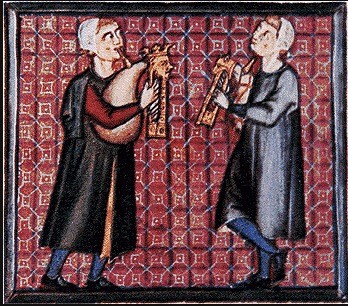
This was a long and constant struggle for musicians, minstrels, to have rank in a society that was strictly tiered and where to belong meant to be trusted. The notion of a person moving from town to town, household to household, unlicensed, uncontrolled, was anathema to those in authority, and minstrels who had no fixed employer were regarded as little more than vagrants and generated great mistrust. Gradually, the musicians who had attained a level of security and status via employment by civic or noble patronage began to organise themselves in order to protect their [precarious] livelihoods, maintain high standards and prevent outsiders from encroaching on their areas of work. Thus, in fourteenth century Paris, a street where musicians would gather and meet, called the rue de Jugleeurs, had its name changed to the rue des Ménétriers and the emergent company of musicians, the Corporation des Ménétriers, officially recognised in 1321, sought to establish a higher position for their trade, and distance themselves, as trained and highly skilled craftsmen, from common street entertainers known collectively as jongleurs.4 This need for eminence was not simply born of a professional pride but as a result of the structure of medieval society that saw civitas as a binding and essential component of the life of a community. Civitas was the concept of the individual applying themselves not only to domestic obligations but to civic duty and as part of a responsible society to which they made a useful contribution.5 The change of nomenclature was another attempt to distance the professional musician from the common street entertainer. This guild of musicians now referred to its members as ‘minstrel’ not ‘jongleur’ and drew up its own statute of rules for musicians in the city and contributed to the sense of civitas by building a hospital and a chapel and contributed to civic ceremony and drama. The minstrels of Paris thereby successfully integrated themselves into society.6
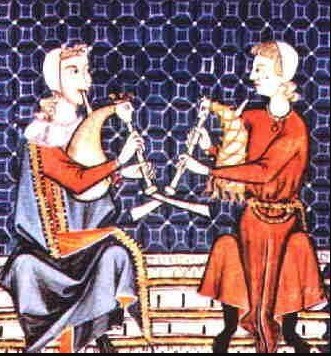
This model for professional station was largely copied throughout European towns throughout the fourteenth and into the fifteenth centuries, and records begin to emerge of court and civic wind bands being regularly employed and provided with official livery, another significant and highly visible status symbol. In England, minstrels were in much the same position: In 1380 a committee of minstrels was formed by the King’s minstrels to control the performance of minstrelsy throughout England [with the exception of Chester, which had a separate arrangement].7 The formation of a livery company for musicians in London did not come to fruition before a faltering attempt in the late fifteenth century and then one more successful in the early seventeenth.
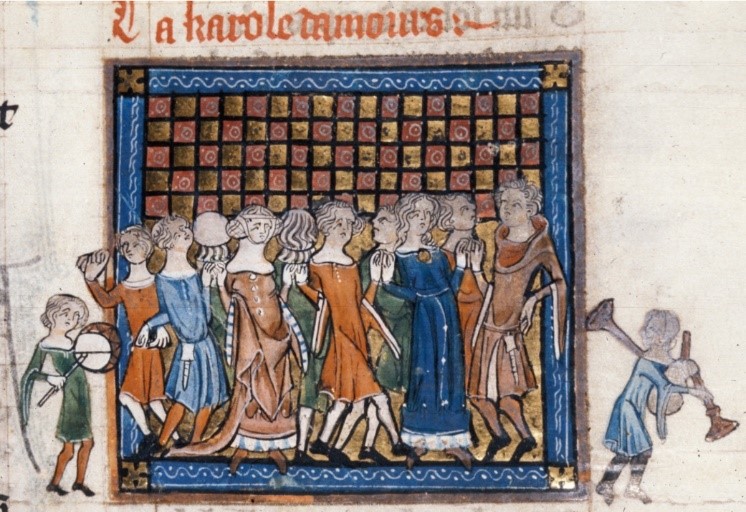
The bagpipes would have been a regular sight and sound in any civic or court band or as a soloist. Many early depictions show bagpipers with a single shawm player, sometimes with percussion and long trumpet. The bagpipes depicted vary to some degree, but the usual design is with single conical chanter, mouth-blown bag and one or two drones. The locale are commonly either in a hall for a feast or out in the open playing for dancing, as mentioned above. The bagpipe remained popular, an essential element of the medieval soundscape. Chaucer’s Miller was a man who:
A baggepype wel coude he blowe and sowne, And therwithal he broghte us out of towne.
Geoffrey Chaucer, Prologue to The Canterbury Tales
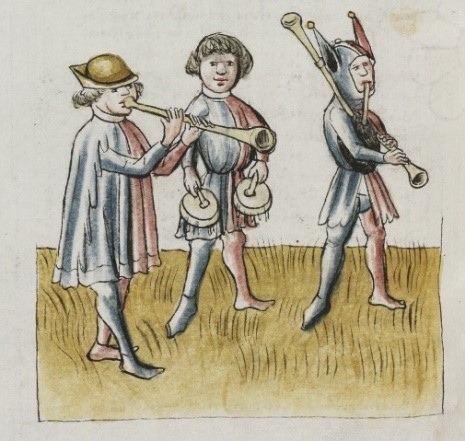
During the fourteenth century, the size of wind bands varied depending on the financial resources of the respective town or court. Generally though, the ensemble comprised between three and six players. Quite how the line-up worked is difficult to define in absolute terms because more often than not the notary or scribe who wrote down the payments for players would refer to them simply as minstrels or use a collective noun such as ‘pipers’, or ‘shalmes’ even when it was most likely a mixed ensemble of shawms and bagpipes. Also, despite up to six or even more wind players being named does not necessarily mean that they all played together all the time, just that these players were being accounted for. If iconography is anything to go by, those depictions of two or three wind players performing together would seem to be the most common number. From the twelfth to the fourteenth centuries bagpipes feature in much of the imagery and often in poetic and other literary references to courtly life and activities. Combinations of solo bagpipes, bagpipes with one or two shawms are most frequent, but pairs of bagpipers are seen also. In John Gower’s late fourteenth century work we hear:
In such acord and such a soun Of bombard and of clarion With Cornemuse and Schallemele.8
Towards the end of the fourteenth and beginning of the fifteenth centuries a subtle shift can be seen in both visual and to a certain extent written record. Groupings of three or four wind players are shown in views of courtly life, but now we are seeing three shawm players, or a band of four, with one player resting, waiting to take the place of a tiring fellow player. Shawms and folded trumpets begin to be depicted, the trumpet possibly being a theoretical proto trombone, the ‘slide trumpet’. What we now see fewer of in this milieu are the bagpipes. Gradually, during the subsequent century, bagpipers as ensemble players on the whole begin to recede into the background and they also begin to be omitted from records of the civic bands around Europe. Of course, they do not disappear altogether, and continue to be included in manuscript illuminations and in representations of bucolic scenes in paintings, tapestries and murals. But why the shift away from its usage as a courtly instrument?
The answer to this can almost certainly be traced to a revolution in the type of repertoire being played by minstrels at court and similarly in emergent powerful city-states. When bagpipes are in an ensemble, it obviously stands to reason that what all play has to be based around the drone. The shawm and piper play either the melody in unison against the drone or employ a two-part polyphony which also works in consonance with the drone. Add another shawm and the result is probably something along the lines of what the present day Italian zampogna provide, namely a combination of drone and rhythmic counter harmony whilst the piffero plays the melody [incidentally, the drones and chanters of the zampogna bear a remarkable similarity in their exterior decoration to the shape of the soprano, alto and tenor shawms of the renaissance]. The master-apprentice nature of minstrel training and the aural transmission of repertoire means that we have virtually no identifiable surviving examples of the music played by the earlier medieval loud minstrels. There was no need for an instrumentalist to read music, and it would seem that their repertoire consisted of numerous long held pieces of music, suitable for processions, weddings, funerals, visiting dignitaries and suchlike. Dances would have occupied a large percentage of the learnt body of pieces.
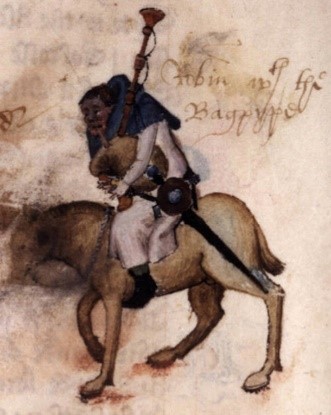
This is not to say that minstrels were averse to learning new music. On the contrary, one of the prime functions of the extraordinary ‘minstrel schools’ [scolae ministrallorum] was to give musicians the chance to learn new repertoire.9 These schools were held regularly in the period before the fourth Sunday in Lent, Laetare Sunday, when minstrelsy was prohibited, and on other occasions when large numbers of minstrels were in the same place, such as for a city fair or church council. The minstrel school was not a place where musicians would go to be educated, it was more akin to a trade fair or convention in that professional musicians would travel from far and wide to attend, buy instruments, gossip, and, most importantly, share and learn new repertoire and styles of playing and find out about new instrument developments. These meetings probably started sometime in the thirteenth century, but the first concrete documentation comes from the fourteenth, when the schools would generally meet every year in various towns across Europe and this phenomenon lasted for some 150 years. English players are known to have travelled to France and the Low Countries to attend these gatherings which were sponsored by the host cities and meant musicians could also be used as diplomatic tools by their respective patrons, bringing gifts, bearing letters and being in attendance.10 Minstrels would have seen these gatherings as an opportunity to create connections and to take new music back to the court or city they were from.
One keen chronicler of these minstrel schools was one Tilemann Elhen von Wolfhagen [1347-c1420], a notary and clerk in his hometown of Limburg, some thirty-five miles from Frankfurt. In 1370 he started chronicling the minstrel schools in Germany and the Low Countries. This account is known as the Limburg Chronicle and covers not just the twenty-eight years of activity after then, but records events from meetings held decades before. One important passage occurs in the entry for 1360, when Wolfhagen states:
‘…In this same year the styles and poems changed in German songs…Things changed also with regard to trumpet and shawm playing, and music progressed, and had never been as good as it has now started to become. For he who was known as a good shawm player, is not worth a fly now.’
Wolfhagen refers frequently to new songs being played by shawms and trumpets and in the original German this reads ‘zu pyffen unde zu trompen’. The word pyffen is taken to refer to shawm rather than bagpipe [known generally as the sackpfeife] although the latter is a possibility, until one considers the type of repertoire being referred to. What Wolfhagen is writing of is a new style of playing and music and the inference is that bands of wind players, shawms and trumpeters [later trombonists], were playing composed polyphony as opposed to taking a melody and creating a version over drones. Therefore, the ensemble playing this new music would have no need of a drone instrument, in fact this would have been a hindrance when performing three voice pieces that would modally move away from the sounding tone of a drone. Combined with the constant movement of composers, singers and other instrumentalists from court to court and state to state throughout Europe, it is no surprise that the band of shawms and trumpets becomes more or less standard from the end of the fourteenth century. A probable consequence of the new repertoire was that minstrels now began to read notation in order to learn the latest compositions. The bagpipes were still present, but not part of this new musical style being embraced, and which was playable on other wind instruments. This is not to say that the bagpipe fell completely out of favour at court or in cities. In the fifteenth century as late as 1481 a pair of sackpfeifen from the court of Brandenburg were with three pipers from the Duke of Bavaria in Augsbug performing with other similar groups of the same instrument.11
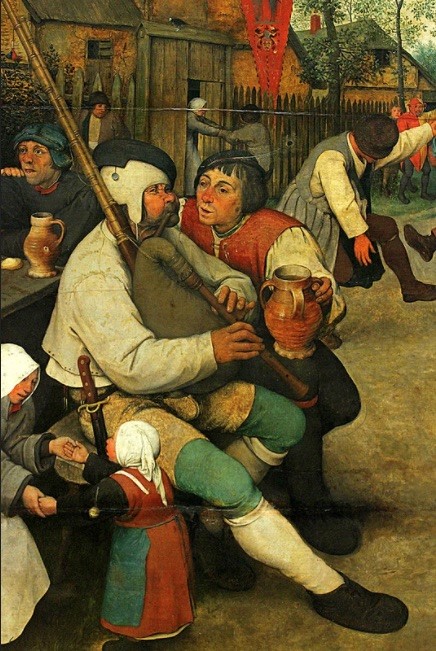
In England, the trajectory away from mainstream music making followed a similar path. However, from the court records of Henry VII and Henry VIII it is clear that a royal bagpiper was in the retinue, in the case of Henry VIII for nearly the whole of the reign. Just two, possibly three, players filled the post from the beginning of the century up to 1570. There are few records from the reign of Henry VII but rewards to ‘hym that pleyeth upon the bagpipe’ and ‘Pudsey the Piper in the bagpipe’ occur in the 1490s.12 In 1511 a piper, William Kechyn, petitioned the new king Henry VIII for a position as a wayte at court, a place he said, ‘he had with the…late kyng’. He was successful and from 1511-1521 was a bagpiper at the court. The records break off then and when they resume his name is no longer present. A certain Andrew Newman ’the wait’ and Queen’s minstrel seems to have taken Kechyn’s place, although he is never referred to as a bagpiper. Finally, we have Richard Woodward, who was royal bagpiper from 1545-1570, playing before Henry VIII, Edward VI, Queen Mary and Queen Elizabeth. After his death in 1570 the post remained vacant for over thirty years, eventually being transformed to that for a bass violist in 1608.13 Whilst it is difficult to say for certain how the royal piper was employed; my opinion is that it was in a solo role rather than as a minstrel ensemble player. The account books show that he was on a different [lower] payment rate than his fellows [although Woodward did successfully petition to have this doubled] and was listed separately from the other wind players. The inventory of the royal households compiled at the death of Henry VIII in 1547 reveals that there was a fine set of ivory bagpipes among the many musical instruments listed.14
From this point on there is no association of pipers with the royal court in England. The civic ‘waits’ bands in towns and cities seem to have stopped using bagpipers, despite their being multi-instrumentalists. Only in places such as Liverpool and others where only one or two waits were employed, rather than five or six [which was the case in the larger, wealthier cities like London and Norwich], then a bagpiper or pairs of pipers were employed.15
Thereafter the tale of the bagpiper as court and city instrument takes something of a downward turn. The references to bagpipers become more derogatory as the instrument came to be regarded with disdain by professional wind players, who, ever conscious of the need for status, only wanted to be seen playing the newest instruments and music. In England, just as centuries before in France, it was the nomenclature that became problematic. The anti-minstrel polemic being spouted by protestant zealots condemned them as doing the devil’s work, and royal decrees determined that common minstrels were no better than vagabonds. The highly skilled court and civic instrumentalists began to refer to themselves no longer as ‘minstrel’, but ‘musician’ and sought to put as much space between the concept of the common minstrel and that of the professional, connected, liveried musician. Bagpipers slipped into the former category, their diminished standing evident in images and in literature. In Thomas Heywood and Richard Broome’s ‘The Late Lancashire Witches’ of 1634, two characters are seeking to drive a devil away and call upon a local piper to help them out: Whetstone:
…I have heard my Aunt say twentie times, that no Witchcraft can take hold of Lancashire Bag-pipe, for it selfe is able to charme the Divell, ile fetch him.
Doughty:
Well said, a good boy now; come bride and bride-groome, leave your kissing and fooling, and prepare to come in-to the daunce. Wee’le have a Horne-pipe…Welcome Piper, blow till thy bagge cracke agen, a lusty Horne-pipe, and all into the daunce, nay young and old Daunce. Lawrence and Parnell reele in the daunce. At the end, Mal vanishes, & the piper.
‘The Late Lancashire Witches’, Heywood & Broome, London, 1634 The piper vanishes …well, not quite. Whilst bagpipes never fully disappeared from the soundscape of England, their position definitely slid downwards from the upper echelons of society. As musical tastes changed along with the instruments that played it, the piper slowly drifted back into the village squares, local feasts and funerals, to the nuptial dances and into the social space of alehouse and the domestic hearth. The revival in France of the musette in the mid seventeenth century led to a welcome change in fortune again for the pipes, this time manifesting not as an instrument of the minstrel but as an elevated imitation of the bucolic, cake eating lower classes, now with intricate pipe work made of exquisitely carved ivory, and silk and satin covers for the bellows-blown bag, played by delicate porcelain-fingered ladies with a spaniel at their feet. Meanwhile, outside, the wine was drunk, the dancers swirled all about, and, as the sun slipped by, the bagpipes prevailed, piping on as their lofty replacements in court and town faded into the shadows.
To find out more about William’s projects and music go to www.william-lyons.com
References
- For example, see the illuminations of the Luttrell Psalter – British Library Add MS 42130, commissioned by Sir Geoffrey Luttrell, c1325-40
- Interestingly, these depictions show the minstrels at ground level. As bagpipes were replaced by shawms and trumpets, a designated raised space, what we now call the ‘minstrel’s gallery’ became common in noble halls in the fifteenth century.
- The separate instrumental groupings were frequently referred to as haut and bas [or variants on these spellings].
- David Whitwell. The Wind Band and Wind Ensemble Before 1500, Austin, Texas, Whitwell Books 2011 p.77
- Nathan A. Daniels. From Jongleur to Minstrel, The Professionalisation of Secular Musicians in Thirteenth and Fourteenth Century Paris. Johns Hopkins University Singleton Center for the Study of Premodern Europe, 2011 pp12-15
- Ibid. p.36
- Whitwell, p.86
- John Gower c1325-1408. Confessio Amantis, Liber Octavus
- Robert C. Wegman. The Minstrel School in the Late Middle Ages, Historic Brass Society Journal (2002) pp. 11-30
- Andrew Wathey. The Peace of 1360-1369 and Anglo-French Musical Relations, Cambridge University Press, Early Music History, Volume IX ,1990, pp.129-174
- Keith Polk. German Instrumental Music of the Late Middle Ages, Cambridge University Press, 1992, pp.54-56
- Andrew Ashbee. Records of English Court Music, Volumes VII & VIII, Ashgate Publishing, 1993
- Andrew Ashbee & Peter Holman. A Biographical Dictionary of English Court Musicians 1485-1714, Volume II, Ashgate Press, 1998
- Ashbee, Vol. VIII p.338. Among the many instruments listed in the two inventories compiled at the death of Henry VIII, there is: ‘Item oone Bagpipe with pipes of Ivery and the Bagg coveryd with purple vellat’
- Walter Woodfill. Musicians in English Society from Elizabeth to Charles I, Da Capo Press, 1953, p.85
- Data Processing Notice (GDPR)
@BagpipeSociety on X (formally known as Twitter)
TheBagpipeSociety on Instagram
 BagpipeSociety on Facebook
BagpipeSociety on Facebook
Something wrong or missing from this page? Let us know!
